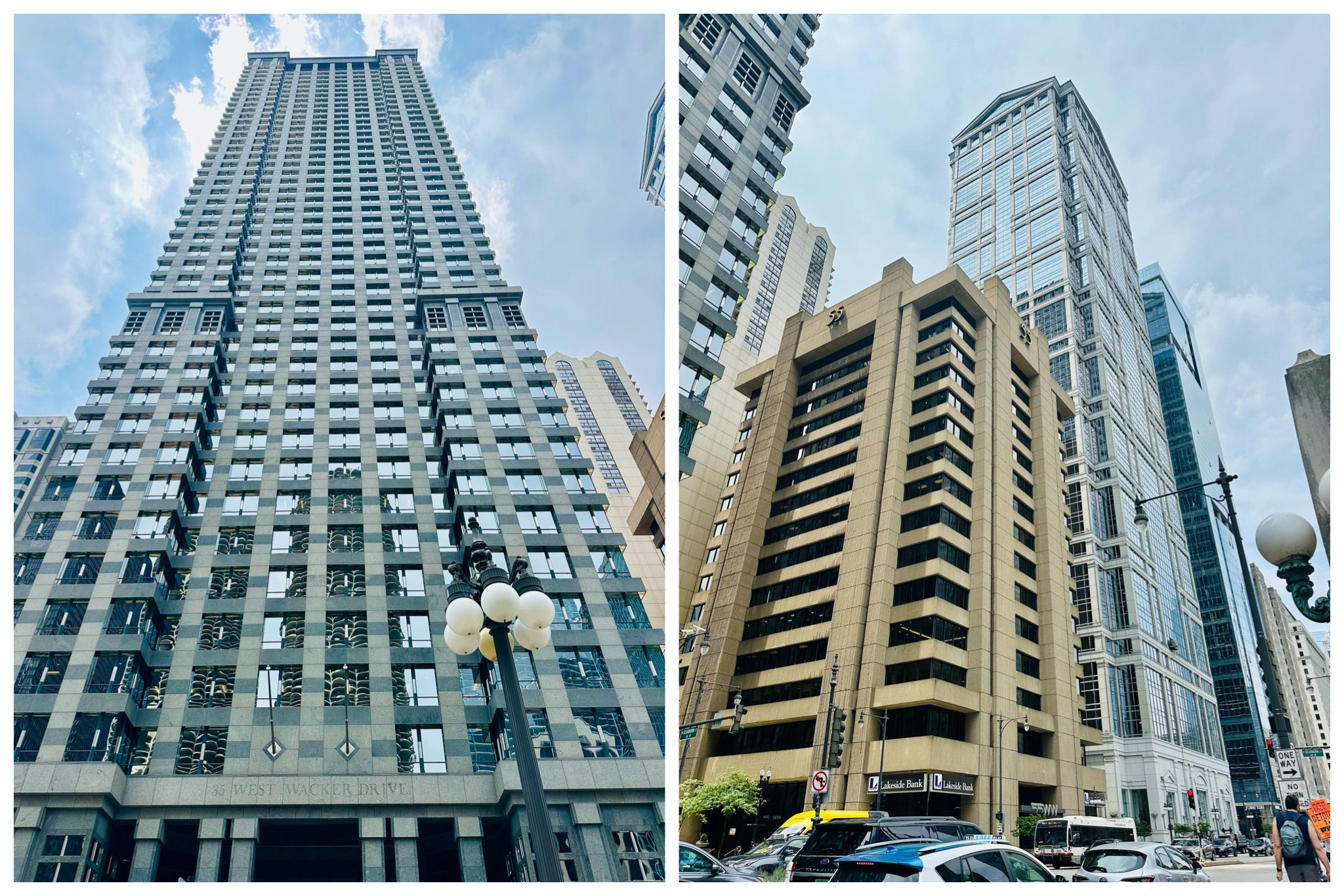Chicago Icons
On Tuesday, we took another walking tour hosted by the Chicago Architecture Center. This one was called Chicago Icons: Connecting Past and Present. It was a bit different from other tours because we looked at buildings in clusters instead of individually.
Our first stop was right near the CAC, at the corner of Michigan Avenue and Wacker Drive, where we could admire the Wrigley Building (1920-24), the Tribune Tower (1923-25), and the London Guarantee Building (1923). Chicago was flourishing at this time, and majestic skyscrapers with historic European flair were built to enhance the city’s prestige. The Wrigley Building’s tower is shaped like the Giralda in Seville; the Tribune Tower resembles the tower of Roen Cathedral; and the London Guarantee has columns and a cupola in the style of ancient Rome.
Left: Wrigley Building and Tribune Tower. Right: London Guarantee Building.
Our next stop was also on Walker Drive, this time by the State Street Bridge, where we looked at three examples of Modernism: the twin towers of Marina City (1963-67), AMA Plaza, formerly the IBM Building (1973), and Trump Tower (1979-1983). They look quite different from one another, but all have a minimalist lack of ornamentation. Interestingly, the Trump Tower echoes both the rounded shape of Marina City and the smooth glass and steel exterior of the IBM Building.
Fun fact: Marina City architect Bertrand Goldberg (a student of IBM Building architect Ludwig Mies van der Rohe) designed the towers to be trees, not corncobs.
Left to right: Marina City, AMA Plaza/IBM Building, Trump Tower.
A little further south on Wacker Drive, we stopped to look at the the Brutalist-style Blue Cross-Blue Shield Building (1968), sandwiched between two examples of Postmodernism: the Leo Burnett Building (1989) and 77 West Wacker, formerly the United Building (1992). Brutalism evolved from Modernism, and the name comes from the French béton brut (“raw concrete”). Postmodernist architects rejected the minimalism and seriousness of Modernism; they brought back ornamentation, but in a more playful way. This was evident in 77 West Wacker, which was topped with a pediment like a Greek temple. In the lobby, humorous sculptures defused the formality of the white marble.




Next we walked to Clark and Randolph, where we stopped right in front of my former Accenture office building to look at the Postmodernist James R. Thompson Center (1985), the Classical City Hall-County Building (1911), and the Modernist Richard J. Daley Center (1965). The Thompson Center, which many say resembles a spaceship, was undergoing renovations and will eventually be the Google Center. We walked through City Hall, admiring the tiled, vaulted ceilings, and then to Daley Plaza, with its iconic Picasso sculpture made from the same COR-TEN steel as the building. Our guide told us an interesting story about the Picasso, which you can read here.)





Our tour ended at Millennium Park, where we stood at Jay Pritzker Pavilion (1999-2004), designed by Frank Gehry. Due to legal restrictions in Grant Park, the pavilion is classified as a work of art rather than a building. When Gehry was a boy, his grandmother would put live carp in the bathtub before making gefilte fish. The pavilion’s curved stainless steel surfaces did indeed resemble shiny, scaly fish. Across the lawn was the Art Institute’s Modern Wing (2009), designed by Renzo Piano. With its straight roof and tall, airy windows, the Modern Wing made me think of an airplane wing. We walked past Cloud Gate (“the Bean”) and headed home, marveling at Chicago’s abundance of iconic architecture.



